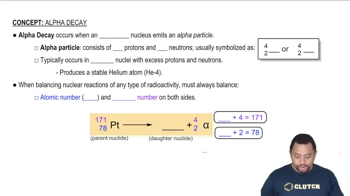Here are the essential concepts you must grasp in order to answer the question correctly.
Nuclear Decay
Nuclear decay is the process by which an unstable atomic nucleus loses energy by emitting radiation. This can occur through various modes, including alpha decay, beta decay, and gamma decay. Each mode involves the transformation of the nucleus, resulting in the emission of particles or electromagnetic radiation, leading to the formation of a different nuclide.
Recommended video:
Alpha Decay
Alpha decay is a type of radioactive decay in which an unstable nucleus emits an alpha particle, consisting of two protons and two neutrons (essentially a helium nucleus). This process decreases the atomic number by two and the mass number by four, resulting in the formation of a new element. It is common in heavy elements, such as radium, which is relevant for Ra-216.
Recommended video:
Nuclear Equation
A nuclear equation represents the transformation of one nuclide into another during a decay process. It includes the symbols for the initial nuclide, the emitted particles, and the resulting nuclide, ensuring that both mass and atomic numbers are conserved. Writing a nuclear equation for Ra-216 involves identifying the decay mode and accurately depicting the reactants and products involved.
Recommended video:



